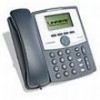Linksys SPA922 Cisco SPA9000 Voice System Administration Guide - Page 81
Configuring a Call Routing Rule, SYNTAX, w, x, y, z, number-pattern, Other elements, EXAMPLE
 |
UPC - 745883570836
View all Linksys SPA922 manuals
Add to My Manuals
Save this manual to your list of manuals |
Page 81 highlights
Configuring Phone Lines and Calling Routing Behavior Managing the Line Selection for Outbound Calls 4 Configuring a Call Routing Rule A Call Routing Rule is a special dial plan that specifies the lines that can be used to transmit a dialed number. The same number pattern can apply to more than one line. SYNTAX: ( number-pattern | number-pattern | number-pattern | number-pattern ) • L: A signifier for "Line" • w, x, y, z: The number of the line interface (L1 for Line 1, L2 for Line 2, and so on) • port: The port number NOTE This parameter applies only if the line interface is configured for a SPA400. • number-pattern: The dialed sequence that can use the specified lines • Other elements: • Enclose the entire call routing rule in parentheses. • Use a comma to separate each digit sequence within a number-pattern. • Use a pipe character (|) to separate each call routing rule. NOTE The Call Routing rules use the same digit sequences as the Dial Plan rules. See "Digit Sequences," on page 66. • Allowing any line interface to be used EXAMPLE: (9xx.) Any line interface can be used for any dialed sequence that begins with 9 and includes at least two additional numbers. The SPA9000 chooses an available line from the list, proceeding in the listed order. See "Line Availability," on page 78. SPA9000 Voice System Administration Guide 79















